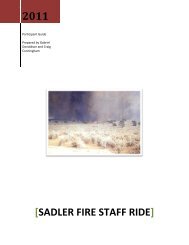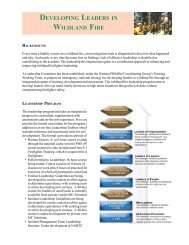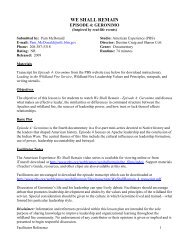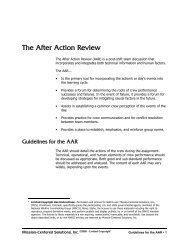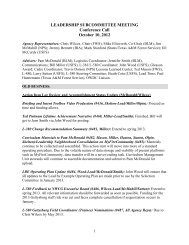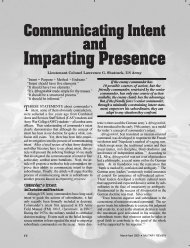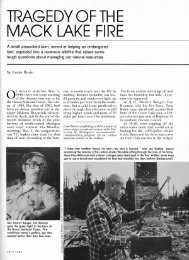example tdgs/stex #2 - Wildland Fire Leadership Development
example tdgs/stex #2 - Wildland Fire Leadership Development
example tdgs/stex #2 - Wildland Fire Leadership Development
You also want an ePaper? Increase the reach of your titles
YUMPU automatically turns print PDFs into web optimized ePapers that Google loves.
Intuitive Decision-making<br />
If you were able to make a 10 second decision in the scenario presented above, chances<br />
are you exercised your experience gained on the fireline and the skill of intuitive<br />
decision-making. The essential factor in intuitive decision-making is experience. That<br />
experience allows recognition of similarities to previous situations. A pattern of typical<br />
cause and effect develops to allow a decision that does not require analysis or reason.<br />
The more experience gained in applying a variety of patterns, the more likely you'll know<br />
what to do.<br />
Tactical Decision Games<br />
There is no substitute for experience of the real thing, but it can be hard to come by and<br />
tragically unforgiving. Fortunately there exists a supplement to the school of hard<br />
knocks. Pattern recognition skills can be improved, and tactical decision-making can be<br />
practiced and refined. Tactical decision games (TDGS) are basically role-playing paper<br />
exercises and in the case of sand table exercises (see below) can incorporate three<br />
dimensional terrain models. The reason for doing TDGS is to provide firefighters with<br />
an opportunity to 1) practice the decision-making process, and 2) practice communicating<br />
that decision to others. TDGS provide a simple, adaptable, and effective method of<br />
repeatedly challenging a firefighter with tactical situations that include limitations of time<br />
and information. By requiring a solution to the situation and the ability to communicate<br />
it in the form of clear instructions, the firefighter will gain precious experience and skill<br />
in actual tactical decision-making.<br />
Recent course development for wildland firefighter training has included: Lessons<br />
Learned: Fatality <strong>Fire</strong> Case Studies, Human Factors on the <strong>Fire</strong>line, Followership to<br />
<strong>Leadership</strong>, and <strong>Fire</strong>line <strong>Leadership</strong>. These courses have appropriately focused attention<br />
on the variable that traditional fire suppression courses have overlooked and the one<br />
variable that will always determine the outcomes of fire suppression activity; human<br />
factors and the decisions they influence. TDGS are a logical step in blending the skills<br />
and tactics taught in conventional wildland fire courses and lessons learned from the<br />
newest body of human factors coursework.<br />
Because the purpose of a TDGS is to build breadth of experience in decision-making and<br />
communication, it is important to employ this process frequently at the crew level. In<br />
addition to developing individual decision-making skills, the practice will allow<br />
crewmembers to learn from each other and to gain an understanding of how each<br />
crewmember makes decisions. Each game played, like every fire experienced, will add<br />
to the collective reservoir of experience in the wildland fire community.<br />
4



